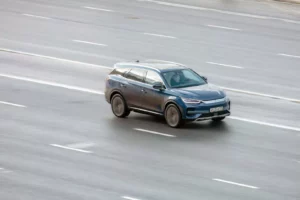Mercedes-Benz USA’s Urban Mobility Solutions division is working to use sensors within vehicles to identify the causes of uneven roads.
Its teaming up with the Boston’s Mayor’s Office of New Urban Mechanics and Citywide Analytics Team to use an advanced algorithm to process vehicle data and use it for infrastructure analytics.
Participating MBUSA vehicles collect information on where they experience bumps in the road. The data are then anonymized, aggregated, and analysed to identify patterns and hot spots of uneven roads. The City of Boston’s Analytics Team will evaluate the effectiveness of MBUSA’s technology by comparing surface damage analytics to data the City has, as well as through on-street inspections.
Vehicle data from these sensors and assistance systems can now provide insights into the vehicle’s surroundings, including infrastructure. While the company has on-going projects in several European countries, this partnership with Boston in the United States is the first in North America. Vehicles equipped with the necessary sensors will not only register bumps along the roadway, but also their intensity and development over time.
“Mercedes-Benz is synonymous with innovation and technology,” said Dimitris Psillakis, President and CEO of Mercedes-Benz USA. “This partnership with The City of Boston aims to offer a deeper understanding of the infrastructure in which vehicles operate by securely gathering, processing, and visualizing anonymized vehicle data. The sophisticated systems in our vehicles can provide valuable insights regarding what is happening along roadways. These data can help effectively and efficiently improve the condition of infrastructure to make roads safer and more enjoyable for everyone to navigate.”
Mercedes-Benz vehicles equipped with advanced suspension systems register bumps during sudden suspension compression and rebound at the front axle, as well as at the rear axle with a certain time delay. A similar algorithm detects speed bumps: in this case via the compression and rebound sequence. Further analysis completed in the Mercedes-Benz Cloud takes vehicle type, wheel spin and damper level into consideration. Since 2021, this capability has equipped Mercedes-Benz drivers with advanced warning of obstacles such as potholes through Car-to-X communication in the vehicle. The Surface Damages data product builds upon this technology and provides valuable data to cities to help monitor, analyse and improve infrastructure.
The City of Boston is experienced in this area, using the accelerometers and GPS in smartphones to identify roadway defects. That experiment — called Street Bump — identified that the biggest defects in Boston’s roads at that time were caused by utility covers that had slightly sunk or shifted over time. That finding reinforced the City’s work with utility companies to maintain their assets in City streets. Similarly, the City is interested in learning from this pilot partnership so that it can provide smoother roads for all via innovative technologies.
Currently, Boston receives information about the status of its roadways through an annual pavement condition review and the City’s constituent service system, known as Boston 311. “It is well known that not all neighbourhoods and communities use Boston 311 at the same rate, yet 311 is a major driver of how some City resources are allocated,” said Stefanie Costa Leabo, the City of Boston’s Chief Data Officer. “We are always eager to find ways to mitigate this bias in reporting, and are excited to evaluate whether by testing new technologies or incorporating these new data we can identify cases that otherwise would have gone unreported and unaddressed in order to distribute city resources more equitably.”
The City of Boston maintains 2,000 lane miles of roadway. Throughout the country, road authorities and road maintenance departments today mostly rely on manual approaches to monitor and maintain the road infrastructure and assets. This results in high internal and external costs and immense efforts to keep the information up-to-date. However, the data quickly become outdated and ad-hoc changes are hard to monitor.
(Picture – Mercedes)





















